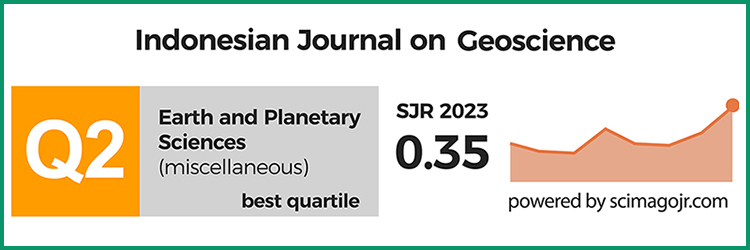The Early Holocene Vertebrate Faunas from Seropan Cave, Gunung Sewu, Yogyakarta, Indonesia
DOI:
https://doi.org/10.17014/ijog.5.1.33-45Keywords:
mammal fossils, Early Holocene, Braholo Fauna, Seropan Cave, Gunung Sewu, YogyakartaAbstract
DOI: 10.17014/ijog.5.1.33-45
An excavation of a vertebrate fossil site was carried out in 2012 in the Seropan Cave of Gunung Sewu karst area, Wonosari, Yogyakarta. Among the discovered mammal fossils there are Cervus sp., Sus verrucosus, Bubalus sp., and Panthera cf. pardus. Small mammal bone fragments of GSP (Gua Seropan/Seropan Cave) Nos. 38, 67, 91-113 have been analyzed for C14 radiocarbon age dating, which gave a date of 9,450 ± 400 yrs. B.P. or Early Holocene. The Seropan fauna is part of the succession series of Braholo fauna that migrated before the Late Pleistocene, and was isolated after the last Ice Age. The Seropan fauna developed and adapted their morphology to the local habitat.
References
Amano, N., Moigne, A., Ingicco, T., Sémah, F., Awe, R.D., and Simanjuntak, T., 2016. Subsistence strategies and environment in Late Pleistocene Early Holocene Eastern Java: Evidence from Braholo Cave. Quaternary International, 416, p.46-63. DOI:10.1016/j.quaint.2015.09.072
Ansyori, M.M., 2010. Fauna oldest occupation layer in Song Terus Cave, Eastern Java, Indonesia, Biochronological significance of Terus Layer. Muséum national d’Histoire naturelle. Master Thesis of Erasmus Mundus en Quaternaire et Préhistoire, p.1-71.
Aziz, F., 2000. The Pleistocene Endemic Fauna of the Indonesian Archipelago. Tropics, 10(1), p.135 -143. DOI:10.3759/tropics.10.135
Badoux, D.M., 1959. Fossil mammals from two fissure deposits at Punung (Java). Drokkerij en Vitgeversmij v/h Kemink en Zoon NV, Utrecht, 153pp.
Bibi, F., 2014. Assembling the ruminant tree: Combining morphology, molecules, extant taxa, and fossils. Zitteliana Reihe B: Abhandlungen der Bayerischen Staatssammlung fur Palaontologie und Geologie, 32 (32), p.197-211.
de Vos, J., 1983. The Pongo faunas from Java and Sumatera and their significance for biostratigraphical and paleo-ecological interpretations. Proceeding B, 86 (4), p.417-425.
de Vos, J., 1985. Faunal stratigraphy and correlation of the Indonesian Hominid sites. Ancestors: The Hard Evidence, p. 215-220.
Erdbrink, D.P., 1954. Mesolithic remains of the Sampung Stage in Java: some remarks and additions. Southwestern Journal of Anthropology, 10, p.294-303. DOI:10.1086/soutjanth.10.3.3629132
Feiler, A. and Stefen, C., 2009. Tigers (Panthera tigris, P. sondaica and P. sumatrae) in the Collection of the Museum für Tierkunde Dresden (Carnivora: Felidae). Lynx, n. s. (Praha), 40, p.153-162.
Frantz, L., Meijaard, E., Gongora, J., Haile, J., Groenen, M.A.M., and Larson, G., 2016. The Evolution of Suidae. Annual Review of Animal Biosciences, 4(1), p.61-85. DOI:10.1146/annurev-animal-021815-11115
Gruwier, B., de Vos, J., and Kovarovic, K., 2015. Exploration of the taxonomy of some Pleistocene Cervini (Mammalia, Artiodactyla, Cervidae) from Java and Sumatra (Indonesia): Ageometric- and linear morphometric approach. Quaternary Science Reviews, 119(September 2016), p.35-53. DOI:10.1016/j.quascirev.2015.04.012
Hardjasasmita, H.S., 1987. Taxonomy and phylogeny of the Suidae (Mammalia) in Indonesia. Scripta Geologica, 85, p.1-68. oai:naturalis.nl:317394.
Haryono, E. and Day, M., 2004. Landform differentiation within the Gunung Kidul Kegelkarst, Java, Indonesia. Journal of Cave and Karst Studies,66(2), p.62-69.
Hunt, C.O., Gilbertson, D.D., Hill, E.A., and Simpson, D., 2015. Sedimentation, re-sedimentation and chronologies inarchaeologically-important caves: Problems and prospects. Journal of Archaeological Science, 56, p.109-116. DOI:10.1016/j.jas.2015.02.030
Kusumayudha, S.B., Setiawan, J., Ciptahening, A.N., and Septianta, P.D., 2015. Geomorphologic Model of Gunungsewu Karst, Gunung Kidul Regency, Yogyakarta Special Territory, Indonesia: The Role of Lithologic Variation and Geologic Structure. Journal of Geological Resource and Engineering, 3 (1), p.1-7. DOI:10.17265/2328-2193/2015.01.001
Kusumayudha, S.B., Zen, M.T., Notosiswoyo, S.A., and Gautama, R.S., 2000. Fractal analysis of the Oyo River, cave systems, and topography of the Gunungsewu karst area, Central Java, Indonesia. Hydrogeology Journal, 8 (3), p.271-278. DOI:10.1007%2Fs100400050014
Marliach, A. and Simanjuntak, T., 1996. A preliminary report on the site of Song Gentong, Tulungagung, East Java. Paper presented at 6th Congress of European Association of SE Asian Archaeologists, International Institute for Asian Studies (IIAS),Leiden September 2-6, p.1-14.
Marwick, B. and Gagan, M.K., 2011. Late Pleistocene monsoon variability in northwest Thailand: An oxygen isotope sequence from the bivalve Margaritanopsis laosensis excavated in Mae Hong Son province. Quaternary Science Reviews, 30 (21-22), p.3088-3098. DOI:10.1016/j.quascirev.2011.07.007
Mazak, J.H. and Groves, C.P., 2006. Original investigation A taxonomic revision of the tigers ( Panthera tigris ) of Southeast Asia. Mammalian Biology, 71, p.268-287.
Meijaard, E., 2004. Biogeographic history of the Javan leopard Panthera pardus based on craniometric analysis. Journal of Mammalogy, 85 (2), p.302-310. DOI:10.1644/BER-010
Meijaard, E. and Groves, C., 2004. Morphometrical relationships between Southeast Asian deer (Cervidae, tribe Cervini): Evolutionary and biogeographic implications. Journal of Zoology, 263 (2), p.179-196 DOI:10.1017/S0952836904005011
Pandita, H., Sukartono, and Isjudarto, A., 2016. Geological Identification of Seismic Source at Opak Fault Based on Stratigraphic Sections of the Southern Mountains. Forum Geografi, 30, p.77-85. DOI:10.23917/forgeo.v30i1.1508
Sémah, A.M., Sémah, F.,Moudrikah, R., Fröhlich, F., Djubiantono, T., 2004. Late Pleistocene and Holocene sedimentary record in Central Java and its palaeoclimatic significance. In: Keates, S.G., and Pasveer, J. (Eds.), Modern Quaternary Research in Southeast Asia, Balkema, Rotterdam, 18, p.63-88.
Simanjuntak, T., 2001. New light on the Prehistory of the Southern Mountains of Java. Bulletin of Indo-Pacific Prehistory, 21(5), p.152-156.
Sondaar, P.Y., 1984. Faunal evolution and the mammalian biostratigraphy of Java. Cour. Forschung Institud Seckenberg, 69, p. 219-235.
Stein, A.B. and Hayssen, V., 2013. Panthera pardus (Carnivora: Felidae). Mammalian Species, 45 (900), p.30-48. DOI:10.1644/900.1
Storm, P., Aziz, F., de Vos, J., Kosasih, D., Baskoro, S., Ngaliman, and van den Hoek Ostende, L.W., 2005. Late Pleistocene Homo sapiens in a tropical rainforest fauna in East Java. Journal of Human Evolution, 49, p.536-545. DOI:10.1016/j.jhevol.2005.06.003
Storm, P. and de Vos, J., 2006. Rediscovery of the Late Pleistocene Punung hominin sites and the discovery of a new site Gunung Dawung in East Java. Senckenbergiana lethaea, 86, p.271- 281. DOI:10.1007%2FBF03043494
Storm, P., Wood, R., Stringer, C., Bartsiokas, A., de Vos, J., Aubert, M., Kinsley, L., and Grün, R., 2013. U-series and radiocarbon analyses of human and faunal remains from Wajak, Indonesia. Journal of Human Evolution, 64 (5), p.356-365. DOI:10.1016/j.jhevol.2012.11.002
Suraprasit, K., Jaeger, J-J., Chaimanee, Y., Chavasseau, O., Yamee, C., Tian, P., and Panha, S., 2016. The Middle Pleistocene vertebrate fauna from Khok Sung (Nakhon Ratchasima, Thailand): biochronological and paleobiogeographical implications. ZooKeys, 613, p.1-157. DOI:10.3897/zookeys.613.8309
Tjia, H., 2013. Morphostructural Development of Gunungsewu Karst , Jawa Island Perkembangan Morfostruktur Kars Gunungsewu di Pulau Jawa. Indonesian Journal of Geology, 8 (2), p.75-88. DOI:10.17014/ijog.v8i2.157
Todd, L.C. and Rapson, D.J., 1988. Long Bone Fragmentation and Interpretation of Fauna1 Assemblages: Approaches to Comparative Analysis. Journal of Archaelogical Science, 15, p.307-325. DOI:10.1016/0305-4403(88)90067-2
Tomar, M.P.S., Taluja, J.S., Vaish, R., and Shrivastav, A.B., 2014. Gross anatomical study on humerus of tiger (Panthera tigris). International Journal of Advanced Research, 2 (3), p.1034-1040. DOI:10.18805/ijar.B-3252(SICI)1099-1417(199709/10)12:5<43::AIDJQS325>3.0.CO;2-E Val, A. and Stratford, D.J., 2015. The macrovertebrate fossil assemblage from the Name Chamber, Sterkfontein: taxonomy, taphonomy, and implications for site formation processes. Palaeontologia Africana, 50 (November), p.1-17.
van Bemmelen, R.W., 1949. The Geology of Indonesia. General Geology of Indonesia and Adjacent Archipelagoes. The Hague, 732pp.
Volmer, R., Hertler, C., and van der Geer, A., 2016. Niche overlap and competition potential among tigers (Panthera tigris), sabertoothed cats (Homotherium ultimum, Hemimachairodus
zwierzyckii), and Merriam’s Dog (Megacyon merriami) in the Pleistocene of Java. Palaeogeography, Palaeoclimatology, Palaeoecology, 441, p.901-911. DOI:10.1016/j.palaeo.2015.10.039.
von Koenigswald, G.H.R., 1933. Beitrag zur Kenntnis der fossilen Wirbeltiere Javas. Wetenschappelijke Mededeelingen Dienst Mijnbouw Nederlansch-Indië, 23, p.1-127.
Wardhana, T.W. and Wilopo, W., 2012. Evaluasi Massa Batuan Gua Seropan, Desa Semuluh, Kecamatan Semanu, Kabupaten Gunung Kidul, Daerah Istimewa Yogyakarta. Gadjah Mada University, p.1-5.
Westaway, K.E., Morwood, M.J., Roberts, R.G., Rokus, A.D., Zhao, J.X., Storm, P., Aziz, F., van den Bergh, G.D., Hadi, P., Jatmiko, and de Vos, J., 2007. Age and biostratigraphic significance of the Punung Rainforest Fauna, East Java, Indonesia, and implications for Pongo and Homo. Journal of Human Evolution, 53(6), p.709-717. DOI:10.1016/j.jhevol.2007.06.002
Wilting, A., Patel, R., Pfestorf, H., Kern, C., Sultan, K., Ario, A., Penaloza, F., Kramer-Schadt, S., Radchuk, V., Foerster, D W., A., and Fickel, J., 2016. Evolutionary history and conservation significance of the Javan leopard Panthera pardus melas. Journal of Zoology, 299(4), p.23-250. DOI:10.1111/jzo.12348



















